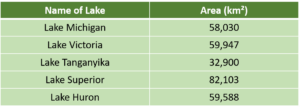Measurement (area & perimeter): Shrinking Lakes
Challenge level ⭐⭐
(designed for children with prior knowledge of the Year 3 and Year 4 programme of study)
Learning Objective
We are learning how to solve a natural world problem by using and applying our knowledge and skills of measurement and area.
Useful prior knowledge:
- To find the area of a rectilinear shape by counting squares
Credit: BBC One - Earth from Space
Clip Description
A lake is a body of water that is surrounded by land. Most lakes are filled with fresh water although some, like the Caspian Sea, are salty. Fresh water lakes can be very small in size with a surface area as little as 15 square metres (m²). By contrast, the largest fresh water lake on the planet is Lake Superior in North America. This lake has a surface area of 82,103 square kilometres (km²).
In this fascinating clip, we journey to Eastern China and Peyong Lake. We learn that this enormous lake undergoes an incredible transformation over the course of a year. When the dry season arrives, it begins to shrink until it almost disappears. Why do you think so many birds are attracted to the shrinking lake? Watch the clip to find out.
Quick Whiteboard Challenge
The table below shows planet Earth’s five largest fresh water lakes.

How much greater is the surface area of the second largest lake than the fourth largest lake?

